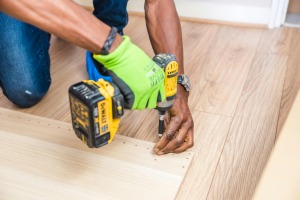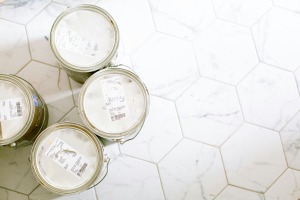


News I published 15 June 2023
Why the trend towards more outsourcing has turned to more do-it-yourself
There are two ways to approach a home improvement project: do it yourself or hire someone else to do it. For many years, there was a growing trend in the European market of outsourcing more and more tasks, resulting in a decrease in the number of projects that people tackled themselves. However, this trend has recently been reversed.
Many recent changes in the do-it-yourself market can be attributed to the effects of the pandemic that we have all experienced, including the significant increase in home improvement projects in 2020 and 2021. However, it would be too simplistic to solely blame COVID-19 for the shift from outsourcing to more do-it-yourself projects, as indicated by the results of the European Home Improvement Monitor conducted by USP Consultancy.
The trend began before COVID-19
For almost a decade, the balance between do-it-yourself projects and outsourced tasks in the European market has been measured. Previously, there was a slow but steady trend towards increased outsourcing and a gradual decline in the share of do-it-yourself projects. The reasons for this trend were diverse, but demographics played a significant role.
As the average age of the population increased, older generations became less capable of doing tasks they used to handle themselves. Meanwhile, the younger generation of consumers showed less interest on average in do-it-yourself activities, resulting in a net decrease in do-it-yourself projects and an increase in outsourcing. Additionally, the market situation was still accommodating in the sense that labor shortages did not yet play a major role, making outsourcing an affordable option.
However, as our results show, the percentage of outsourced tasks reached its peak in 2018 and began to decline thereafter. Since then, the share of do-it-yourself projects has steadily increased and continues to rise. It is important to note that there was no pandemic in 2018 and 2019. Therefore, the reversal of the trend from outsourcing to do-it-yourself projects cannot be attributed to the COVID-19 crisis alone.
Lockdowns may have acted as a catalyst
Although the pandemic may not have been the cause, it is known to have had a significant impact on the do-it-yourself market. Due to COVID-19 restrictions, more consumers were confined to their homes and unable to spend money on outings or vacations. This meant they had more reasons, time, and budget to engage in home improvement projects.
As a result, the number of projects that consumers undertook in their homes increased significantly. Additionally, many people who would not typically attempt such projects themselves started doing DIY work during the pandemic. This allowed them to gain some experience, increase their self-confidence, and perhaps find enjoyment and pride in completing projects on their own.
We know that there is a strong correlation between the amount of DIY experience and the likelihood of someone tackling projects themselves instead of outsourcing them. It is likely that people who started engaging in DIY projects during the pandemic have continued to do so. Therefore, while the pandemic may not have caused the shift towards more do-it-yourself projects, it did serve as a catalyst for that trend.
Labor shortages are the key factor
So, if COVID-19 did not cause the trend reversal, what did? The predominant reason is that in the years leading up to the pandemic, labor shortages were becoming more pronounced in the construction and renovation sectors, resulting in higher labor costs. This prompted many consumers to start doing home improvement projects themselves, saving on labor costs and investing in materials instead. This was also true for the older generation, who continued to engage in projects for longer than expected.
At our latest measurement point, by the end of 2022, we see that the trend towards more do-it-yourself projects is still ongoing. Meanwhile, labor shortages are even more significant than before the pandemic, and inflation and high material

Read more


12 December 2024 I Dirk Hoogenboom
Buying Behavior of Handymen


12 December 2024 I Henri Busker
Handymen Radar – Private Labels vs. Branded Products


12 December 2024 I Dirk Hoogenboom
Sustainability and Painting – What Matters Most?


12 December 2024 I Zeynep Kutsal
Are European Painters Getting Younger?

Fresh Insights Await
Our relevant reports
Delve into the newest findings across various market segments, crafted for a cutting-edge overview. Explore our insightful reports, brimming with up-to-date data, trend analyses, and in-depth examinations, all tailored to provide you with a comprehensive understanding of the current market dynamics.
Construction
Home Improvement
Installation
Special reports
Construction
Decision making process Q3 2024
2024 87 pages
Unveil the decision-making processes in the construction industry through the lens of European architects. Discover the factors that influence crucial decisions and the interplay among different stakeholders.
1,850 Euro
Construction
Prefab H1 2024
2024 63 pages
Discover the adoption rate and benefits of prefabrication technology among European contractors in H1 2024. Understand the driving forces behind prefab usage and its impact on project efficiency and cost-saving.
6,300 Euro
Construction
Sustainability 2024
2024 72 pages
Painter Insight Monitor 2024 will focus on understanding the specific needs, preferences, and challenges faced by painters when it comes to sustainable products.
10,815 Euro
Construction
Importance of branding & branding funnels 2024
2024 62 pages
This report offers a comprehensive overview of importance of branding and branding funnels with a specific focus on European handymen. Brand behaviour is covered for each country, showing purchasing power, differences regarding quality, sustainability, online shopping, innovation-habit and private labels,
8,400 Euro
Construction
Future of construction Q2 2024
2024 82 pages
Explore the evolving future in construction sector among European architects in Q2 2024. Delve into the factors driving material preferences and the impact on construction aesthetics and sustainability.
1,850 Euro
Construction
Trends in material usage Q1 2024
2024 102 pages
Explore the evolving trends in material usage among European architects in Q1 2024. Delve into the factors driving material preferences and the impact on construction aesthetics and sustainability.
1,850 Euro
Home Improvement
European Garden Monitor
2023 43 pages
Explore the European Garden Monitor, a comprehensive platform dedicated to garden health monitoring in Europe. Access valuable resources and expert advice today.
12,000 Euro
Home Improvement
Purchase channels Q2 2024
2024 90 pages
The European Home Improvement Monitor offers valuable insights on purchase channels in the European home improvement industry, examining the evolving preferences and behaviors of consumers across traditional retail and emerging online platforms.
3,150 Euro
Home Improvement
Sustainability Q1 2024
2024 81 pages
Delve into sustainability trends in the home improvement sector in Q1 2024. Discover consumer preferences and the shift towards eco-friendly home improvement solutions.
3,150 Euro
Home Improvement
DIY versus DIFM Q4 2021
2024 113 pages
This report is a must-have if you’re in the home improvement industry. It provides a wealth of information on the behaviour of DIY and DIFM consumers, their motivations, and the factors that influence their purchasing decisions.
3,150 Euro
Home Improvement
DIY or DIFM Q4 2023
2024 70
Explore the prevailing trends between DIY and DIFM in Q4 2023. Understand consumer preferences and the factors influencing their choice between DIY and DIFM.
3,150 Euro
Home Improvement
Branding Q3 2023
2023 93 pages
This report offers an extensive overview of the home improvement industry, with a focus on branding and the most popular brands within different categories. Within this report, you will gain insights into how customers perceive home improvement brands and what motivates them to buy certain products.
3,150 Euro
Installation
Prefab Q3 2024
2024 110 pages
Uncover the adoption of prefabricated products in HVAC installations during Q2 2022. Delve into the benefits and challenges associated with prefabrication in HVAC.
2,650 Euro
Installation
Branding Q3 2024
2024 74 pages
Discover the power of branding in the home improvement sector. Explore how strong branding influences consumer preferences and purchase decisions.
3,150 Euro
Installation
Prefab Q3 2024
2024 119 pages
This report offers a comprehensive view of the installers’ involvement and needs regarding prefabricated electrical installations.
3,150 Euro
Installation
Smart & Connected Products Q2 2024
2024 120 pages
This report provides a comprehensive view of the attitudes of installers toward smart building solutions, specifically among electrical installers and their clients. In the report, you will find insights into the installers' experiences with installing smart products and the willingness of end users to invest in such solutions, as well as their motivations and pain points.
3,150 Euro
Installation
Smart and connected products Q2 2024
2024 129
This report provides a comprehensive view of the attitudes of installers toward smart building solutions, specifically among HVAC installers, plumbers and their clients. In the report, you will find insights into the installers' experiences with installing smart products and the willingness of end users to invest in such solutions, as well as their motivations and pain points.
3,150 Euro
Installation
BIM Q1 2024
2024 84 pages
The European Mechanical Installation Monitor report provides a detailed analysis of the plumbing and HVAC industry. This report specifically focuses on BIM adaptation in the industry.
2,650 Euro
Special reports
European Sustainability Report 2024
2024 51 pages
This report provides in-depth insights based on triangulation of key market information and data as well as data from USP Marketing Consultancy’s key monitors that are carried out year in, year out. The focus of this report is on the most important stakeholders within the construction industry, namely architects, contractors, electrical and HVAC installers within The United Kingdom, The Netherlands, Belgium, Germany, Poland, France, Italy, and Spain.
3,950 Euro








